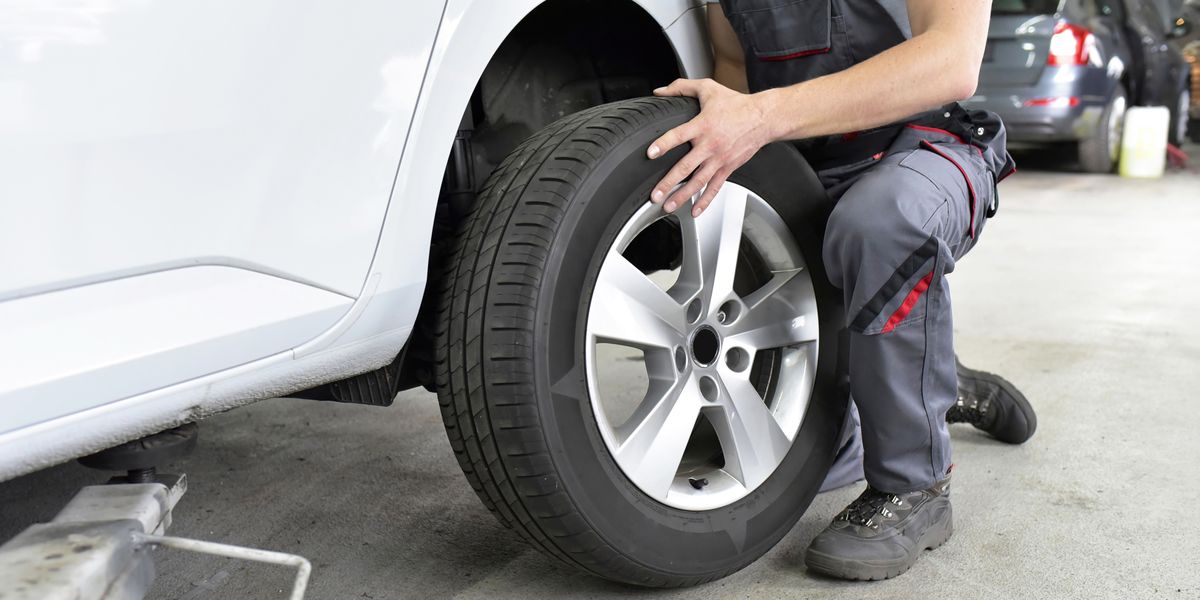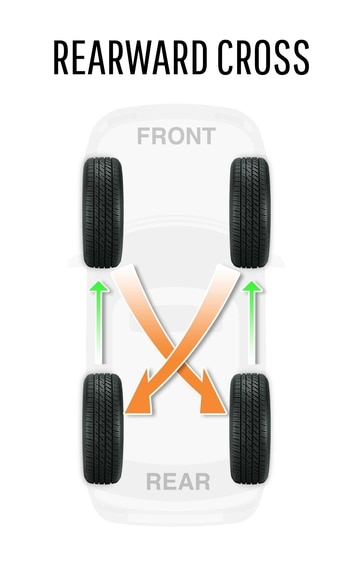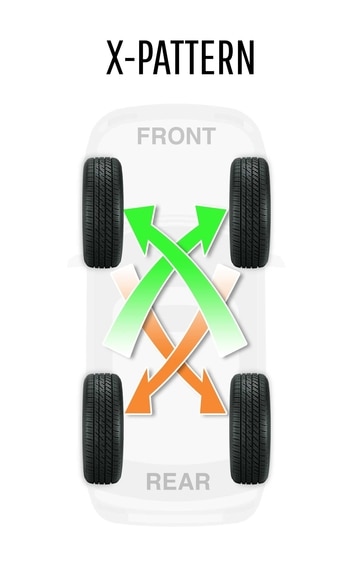Oh boy. This might be more fun than transmission fluid discussions!
You will get every answer in the book for same-size, non-directional tires. When crowd-sourcing your auto repair information, you still need to decide what you will do. I suggest checking the tire manufacturer's site.
In this post below:
1) Recommended tool for DIY tire rotation
2) AWD differential discussion
3) Toyota contradicts itself in the early vs. late Gen 1 HL owner's manuals
4) Survey of what some major sites say.
5) What I think, including tire aging and wear limit
6) Links to major sites
7) Diagrams defining common 4 wheel, same size, non-directional rotation patterns.
Good luck.
DIY
If you do your own tire rotation or seasonal tire change, check out the tire jack from Harbor Freight. Makes it easy to install the tires when using a floor jack to lift the car. Tires can be raised, lowered, and rotated to align with the hub without killing your back. Wait for it to go on sale, but you only need one. I wrap a bungie around mine to hold it together. If you get one, you will see what I mean. Picture is at the bottom of this post.
1250 Lb. Capacity Vehicle Positioning Wheel Dolly SKU(s)61917, 67287, 62234
Differentials
The 2005 AWD has open differentials, so it is not as sensitive to differences in tire wear and diameter differences as the AWD cars with viscous couplings or clutches are, but it is still best to keep all the tires at the same tread depth and rolling diameter to reduce the additional wear and heat on the differentials and lube.
In contrast, the 2001 to 2003 AWD has a viscous coupling in the transfer, and in some cases (without TRAC) has a viscous coupling in the rear differential. Viscous couplings can overheat and burn up if the difference between rolling diameters is too great. I have not seen where Toyota gives a specification for the rolling diameter tread difference, but they do specify that all tires be the same brand (and I assume model), size, and construction. (As I sidenote, I have heard that Volvo is known to be among the worse for sensitive viscous couplings.)
Toyota Contradicts Itself
Speaking of the book, the owner's manual for the 2001 HL shows a 5 wheel forward cross (RF > RR, RR > LF, LR>RF, LF>spare, spare>LR) No differentiation between FWD and AWD patterns.
However, the 2005 owner's manual shows a 5 wheel straight rotation (single side): RR>RF, RF>spare, spare > RR, LF>LR, LR>LF. Again, no differentiation between FWD and AWD patterns.
This is for essentially same vehicle! Why did they change their minds? No explanation.
And that is what you typically find - an assertion without much explanation.
However, they did change the AWD system from a viscous coupling in the transfer case to all open differentials in 2004, which may make a difference in tire wear. Open differentials split torque fairly evenly most of the time, but with the earlier system a properly working viscous coupling and same-size tires there is enough slip that the rear tires don't get much torque unless the fronts slip or the rears lock, creating a shaft speed differential, so they wear pretty much like FWD.
Other Major sites
Bridgestone also contradicts itself -
In their "Tire Rotation 101, they state that AWD should be a "double cross" or "X" pattern with LF>RR, RR>LF, RF>LR, LR>RF.
Then in the embedded video they show a rearward cross for an AWD!!!
The tire industry association says double-cross for AWD.
Tire Rack likes the rearward cross for AWD and RWD.
Some independents, like Christian Brothers Olathe state that radial tires should be kept on the same side. So does Volvo.
America's Tire wants you to check your owner's manual.
And a webpage apparently from Volvo does not recommend rotation at all because wear is primarily dependent upon other factors, and if you decide to rotate, certainly do not cross them.
My Input
I remember the days when radial tires first became popular. I was taught to keep them on the same side. (William Crouse, Automotive Mechanics, 7th Edition 1975, p.580), ("How to Rotate Radial Tires," The New York Times, April 8, 1973, p.602). They took a set, and reversing rolling direction could create create a pull or wander, additional friction, heat, wear, and possibly belt separation.
The Bridgestone site alludes to a "straight" same-side, front-to-back rotation pattern as originating with radial tires. (But a couple of other independent sites state that straight same-side was recommended for bias ply. However, according to the NYT article at the time, bias ply and belted-bias ply tires were crossed. That's what I remember and what is in the textbook.)
But the general wisdom now is that the early radial tire design and manufacturing issues were resolved, and now there is no reason to not cross radial tires. However, I have never seen a technical discussion of what was changed.
With that said, tires seem to wear pretty fast on our HL's, so if tire life is a major concern, I think the rearward cross is probably the way to go.
In a cross rotation, does it really matter whether it is a forward cross or rearward cross? I don't see it for a forward cross. I cannot find a reference as to why it is done the way it is done. In fact, intuitively, I move the right front, which I normally expect to wear the most, to the left rear so it can have an easier life for a while, rather than to the right rear, where I would expect it to get further abuse. I do not see the logic in a "X" or double-cross pattern for AWD at all. Maybe someone else knows the logic for these patterns.
What I do depends upon the vehicle.
For my main tow / vacation vehicle, I am extremely conservative. Old habits die hard.
I do a straight rotation, front to back, no cross every 5000 to 6000 miles, every other oil change. Tires tend to wear fastest with more tread, maybe from tread squirm, so doing the first rotation or two at 3000 miles may make sense.
I age-out tires on these vehicles at 5 years, including the snow tires.
For my around-town cars (fwd or awd), I will do a rearward cross and age-out at about 6 to 8 years, depending on condition and manufacturer's recommendation.
If I do a 5 tire rotation, which I don't usually do, I put the spare on the right.
Tire wear
I like the America's Tire graphic for wet stopping distances vs. tread depth.
'nuff said.
Some Fun reading:

www.americastire.com
Besides checking the inflation pressure on a monthly basis, the best way to maximize tire life is to rotate the tires every 5,000 – 7,000 miles, depending on your vehicle. During rotation, each tire and wheel is removed from your vehicle and moved to a different position to ensure that all of...

www.tireindustry.org
Discover tire rotation, balancing, and alignment information from Bridgestone. Learn more about tire rotation to maximize your vehicle's performance here.

www.bridgestoneamericas.com
Tire rotation patterns

www.tirebuyer.com
Follow these tips to make your tires last longer and your car drive better.

www.caranddriver.com
At Christian Brothers Automotive Olathe, our staff hears common auto repair myths every day. Many of the misconceptions involve a standard maintenance service: tire rotation. Today, our car shop in Olathe will set the record straight. Here are three tire rotation myths, busted by our...
www.cbac.com

volvo.custhelp.com

www.motor.com
Patterns
















